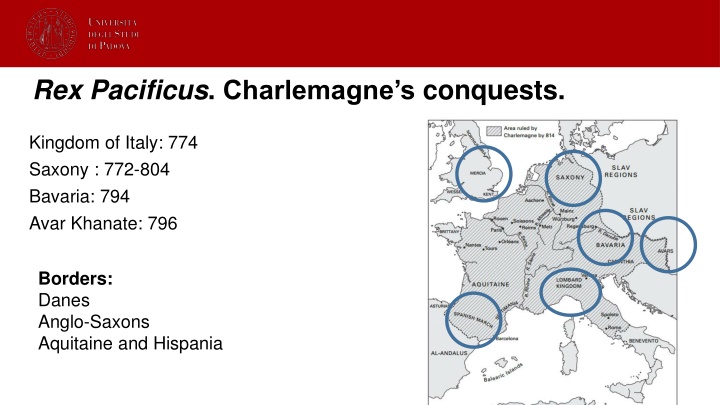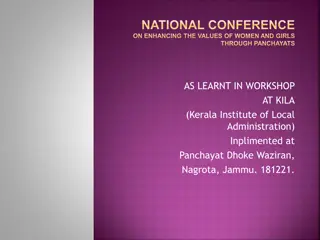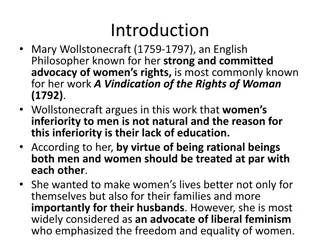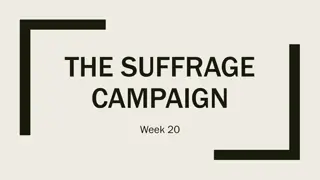
Charlemagne and the Carolingian Empire: Conquests, Domination, and Legacy
Explore Charlemagne's conquests like subduing the Kingdom of Italy and Saxony, and the resulting territorial domination, followed by a period of crisis under Louis the Pious and the aftermath of the Treaty of Verdun in the Carolingian Empire. Learn about the administrative structure and challenges faced by the empire, shedding light on its unique governance style.
Download Presentation

Please find below an Image/Link to download the presentation.
The content on the website is provided AS IS for your information and personal use only. It may not be sold, licensed, or shared on other websites without obtaining consent from the author. If you encounter any issues during the download, it is possible that the publisher has removed the file from their server.
You are allowed to download the files provided on this website for personal or commercial use, subject to the condition that they are used lawfully. All files are the property of their respective owners.
The content on the website is provided AS IS for your information and personal use only. It may not be sold, licensed, or shared on other websites without obtaining consent from the author.
E N D
Presentation Transcript
Rex Pacificus. Charlemagnes conquests. Kingdom of Italy: 774 Saxony : 772-804 Bavaria: 794 Avar Khanate: 796 Borders: Danes Anglo-Saxons Aquitaine and Hispania
Charlemagnes domination The result of Charlemagne's thirty years of warlike activity was the creation of a territorial domination enormous for its time, whose borders largely coincided with those of the Christian world. From it remained outside realities that could be considered peripheral (such as the British Isles); large Christian realities tainted by heresy, such as the iconoclastic empire of Byzantium. Heresy according to the doctrine professed by the Western churches and especially that of Rome, which had established a privileged link with Charles.
Louis the Pious (814-840). The crisis of a fragile system. Succession: Ordinatio imperii (817) The Revolt of Bernard, son of Pippin of Italy (817) The competition between brothers for the imperial title (817-843) 843: The Treaty of Verdun. Admonitio The Council of Aachen (816) De institutione laicali (820) The second marriage (820) 828: The condemnation of counts Hugo and Matfrid 830- 834: The crisis and public penance.
After the Treaty of Verdun (843) Stabilisation of regional aristocracies Monastic estates Formation of specific local characteristics In reality, a plurality of Carolingian kingdoms had always existed; the novelty of Verdun lay not in the division of the empire, but in the fact that a system arose from it in which all three brother-sovereigns enjoyed de facto political parity, although Lothar retained the imperial title and moral supremacy over his brothers. Louis the German Charles the Bald Lothar
Administrative structure At the summit of the public apparatus was the imperial palace, a pale imitation of the late Roman and Byzantine bureaucratic machine. It coordinated the exploitation of the large landed estates of the public treasury, which represented the material basis for the maintenance of the court and the central apparatus of Carolingian rule. No attempt was made to re-establish a system of land tax collection. In addition the members of the palace and the sovereign himself could count on the maintenance of the landed aristocracy, both lay and ecclesiastical, when the court travelled. The Carolingian Empire never had very sophisticated administrative structures. It lacks: a homogeneous and well-distributed network of officials, a uniform system of territorial districts. Moreover, the various kingdoms absorbed into Charles' empire - for example, the Lombard kingdom - continued to have a relatively autonomous life of their own.
The moral duty of Carolingian emperors Carolingian emperors had the moral duty of taking their subjects to heaven. Therefore they had to give good instructions: Bishops and ecclesiastical intellectuals were looking those instruction in the Bible: Biblical exegesis Episcopal Councils. Pippin III and Charlemagne: CORRECTIO Louis the Pious: ADMONITIO
Violence, war and peace In the Eighth-Century Gelasian Sacramentary of Gellone, organised violence was classified in three ways, providing for various eventualities: there were prayers in time of war (in tempore belli), >that the Roman Empire should have peace<; prayers in time of dispute (in contencione), >that we should shun perverse enterprises and always love holy justice<; a prayer pro invidia hominum, >that we may be freed from the brigandage of wicked men (latratus hominum pessimorum), so that once the filthy contagion of their vomit is removed, they may not pollute our purity<''.
Potential war These varieties of organised violence could be seen as points along a scale of magnitude. War, feuding and crime were distinguished in principle. In practice, they were not very clearly differentiated. While kings aspired to impose peace, there was nothing like a state-monopoly of legitimate force. Early medieval kingdoms coexisted uneasily, perpetually exposed to the threat of neighbours' subversion, and to the Iure of raiding and plundering those same neighbours. Even when not overt, violence, within and between realms, often seems to lie just beneath the surface of early medieval narratives: one way or another, there was >a permanent State of potential war<.
Peace and the Frankish Church Actual Carolingian State was normally one of precarious peace. The Frankish Church preached peace, and prayed for it incessantly. Peace did not look like the suppression of war: on the contrary, it was war that seemed a negation of peace . As the Carolingian Reforms began to bite, the lay elite in northern as well as southern Continental Europe became more numerous among the consumers, and even the producers, of the written word. Their texts held up to them social values, including negative attitudes towards violence and sexuality, which had largely been constructed by ecclesiastics; such models for elite laymen had been handed on from the world of Late Antiquity assumed a civilian lifestyle, whereas the lay elite of the Carolingian world was military by profession.
Instructions for laymen Alcuin writing his manual for Count Guy of the Breton March concentrated on the count's private life: on >the inner disposition towards peace without which his offerings to God were nothing<. Jonas of Orleans, advising Count Matfrid in 820, concentrated on the duties of Christian marriage (within which sexual relations were strictly for procreation) and domestic peace. Yet a count's public life involved, ex officio, the direct use of violence: in tempore belli, in contencione, and in cleaning up the unpleasant mess left by brigands' activities.
Internal peace Charlemagne worried about attacks by armed bands of horsemen on people travelling to the palace; and he had been prepared to make men end their feuds (faidae), if necessary by deporting those who refused to accept settlement. The word >peace< became commoner in captularies, no doubt through Alcuin's influence. In 805 Charlemagne called dispute-settlement >peace< when he forebade the carrying of spears (but not swords) infra patria, adding: >if a man is conducting a private dispute (faidosus) missi are to establish which party is refusing to settle, so that they may be pacified (pacati sint), and they will be compelled to peace even if they don't want it (distringantur ad pacem etiam si noluerunt).
Everyday violence: the young nobles. Young nobles joined such bands of commilitones to gain experience, make friends, seek fame and fortune. A problem of social control thus compounded the political one: the iuvenes. Campaigns (itinera) were regular annual events; the maintainance of pax in itinere was a recurrent problem. Contingents destroyed crops, seized fodder to feed their horses, stole and ravaged within the realm, long before they had reached enemy territory. There never was a very tidy fit between the ecclesiastical definition of the objects of offensive (yet just) war, namely pagans or heretics, and the reality, namely that the Franks' opponents were mostly their Christian neighbours.
War and profit. In the heyday of Charlemagne's empire, thanks to imperial expansion, and the regular deployment of large numbers of potentes, and hence of young men, in aggressive war, a good deal of violence had been projected outside the patria. This changed in the ninth Century. From c. 805, the Franks encountered >a shortage of victims who were both conquerable and profitable<. That meant new limits to the attractiveness of collective violence outside the Frankish realm as >previously subdued peoples defected and a shortage of wealth began to afflict the realm<.
Internal war This was war of a kind. Werra, unlike bellum, was a private affair, and because it was not waged in defence of the res publica, it could never be legitimate in the eyes of churchmen. Augustine had not prescribed for werra justa. In the 850s, Hincmar of Rheims would castigate the pratitioners of werra as praedatores, latrones, raptores, and homines cabalarii. These men were not social upstarts, but rather, the sons and grandsons of the men who had made Charlemagne's empire. A non-expanding regnum depended on the management of latrocinium within its own frontiers.
Youthful joking-behaviour could become a social problem. One mid-ninth-century evening, coming home from hunting together, >a young man jumped on another - it was a young man's idea of a joke - and pretended he was trying to steal his horse<. In the brawl that followed, the assailant was fatally injured. In another story, a young man was chasing a girl he fancied and when she fled into her father's house, >being a young man, for a joke he tried to ride through the doorway<. The young man died from internal injuries. Seniores, who were literally seniors as well as lords, needed to establish their authority over wild young men: Ninth-century battle-training was designed to convert wildness into disciplined tactics. Military exercises could turn nasty and the participants strike to wound in earnest: well executed manouevres impressed, by contrast, because of the commanders' control over their young followers.
The control of the iuvenes Behind the youth-training problem there was a youth-employment problem: now that warfare beyond the frontiers had become a rarity, there were fewer job opportunities for the noble young. While monasteries absorbed large numbers in spiritual warfare, many young still sought the followings of lords, including ecclesiastical ones. Martial skills, as in the case of Bishop Theodulf's primates homines, had now to be directed against the strongholds and the followings of other potentes. Competition for followers' loyalty increased. Looking back from the 850s, Paschasius Radbertus thought that a turning-point had come in the reign of Louis the Pious, in the Carolingian family-disputes of the early 830s. Before then, a distinction between brigands and noble followings had been possible, but now, the followings consisted of brigants: >hardly anyone can keep his milites behind him for a fair wage, but only by acts of pillage and violence< rixas et dissensiones ... quas vulgus werras nominant.
Internal war and the stability of the State Could a Carolingian State survive once expansion was off the agenda? The Roman Empire had survived for centuries without expanding its frontiers. What did those Roman soldiers do with their time? The State had to use them often enough to crush rebellion; there were often civil wars to be fought. But if monopoly of legitimate force is seen as an essential of state-hood, there are problems with the Later Roman Empire. Thugs and brigands - latrones, praedones - were a permanent part of the late antique landscape. The state's use of the army to maintain internal order was only ever partially successful. The State recruited latrones itself, to turn them against other latrones. It used them thus indirectly, through the good offices of local elites: the men who ran local government knew whom to call on for protection.
Succession A non-expanding regnum depended on the management of latrocinium within its own frontiers. Thus Late Roman Emperors and Louis the Pious faced similar situations. A further similarity, which had equally important implications for the incidence, and management, of violence. Theirs were states with similar succession-systems. Bureaucratic-appointive, with an elective dash, the Later Roman Empire's System may once have appeared. In the time of the Christian Emperors the hereditary element loomed large, bringing with it the distinctive trait of partitioning between heirs. The empire was split between east and west in 396 because Theodosius left two sons. In 337, Constantine left three sons and the empire was split into three: the eldest got their father's patrimony, the western provinces, and Constantinople only after further negotiations with the second son, ruler of the east; the youngest son got Italy and Rome. A res publica could be treated like a patrimony.
Only the deaths of his two eider brothers enabled Louis the Pious, the youngest, to succeed to the whole inheritance. Such confusions and contradictions of principle were symptoms, more than causes, of conflict within the ruling family. Those confusions were compounded after Charlemagne's death. It was the fault-line inherent in the system of dynastic succession, in family or State. The scarcer the resource and the more valuable the prize, the more likely was filial rebellion. Equally likely, and more violent still, was conflict between brothers, a fortiore between half-brothers.
Early in Louis the Pious's reign, Lothar's ecclesiastical supporters had argued for an impartible regnum Francorum, and for succession by primogeniture. Such was the scheme embodied in the Ordinatio Imperii of 817. In the late 830s, partible succession of the heartlands returned to the agenda with a series of succession schemes and division-projects announced by Louis the Pious between 837 and 839. Fideles hardly knew from one year to the next in whose realm they should expect to end up. Uncertainty must have bred further insecurity during these frenetic years. Imitator of Christian Roman Emperors, Louis treated the empire like a family inheritance, exercising his rights like a Roman paterfamilias to promote, demote, exclude potential heirs.
Lothar, the first son of Louis the Pious Lothar Pippin Louis the German Charles the Bald (from another mother) In 838 the whole empire was divided - on parchment - between Lothar, the primogenitus, and Charles the Bald, the youngest son. In 840, on his deathbed, Louis bequeathed the imperial regalia to Lothar, who twenty-three years before had been promised the patrimony of Francia entire. Lothar was determined to make a reality of his imperial pre-eminence: he therefore needed Francia where Carolingian lands and resources were concentrated. To his brothers' supporters, Lothar's conduct >breached the laws of nature< - in other words, of fraternal sharing. How far was Lothar prepared to go? In the last the last throes of his rebellion in 833/34, the level of violence within the Frankish realm had escalated dramatically. A chain reaction of violence.
The siege of Chalon-sur -Saone Nithardus, 1.5 (y. 834) Cavillionum collecta manu valida venit, civitatem obsidionem cinxit, praeliando triduum obsedit et tandem urbem captam una cum ecclesiis incendit. Gerbergam, mole maleficorum, in Ararim mergi praecepit, Gozelmus et Senilam capite punivit, Warino autem vitam donavit et, ut se deinceps pro viribus iuvaret, iureiurando constrinxit. Hinc autem Lodarius et suis, duobus praeliis feliciter gestis magnanimes effecti, universum imperium perfacile invadere sperantes, ad cetera deliberaturi, Aurilianensem urbem petunt.
The siege of Chalon sur- Saone Astronomus, Vita Hludovici imperatoris, c. LII (a. 834) [Hlotarius] castrum Cavillionum improvisum venire disposuit, quod tamquam facere nequivit. Advenit tamen et oppidum circumdedit; quae in circuitu civitatis erant, incendio conflagrata sunt. Pugnatum est acriter diebus quinque et tandem ad deditionem urbs recepta est. Post autem versa vice crudelium more victorum primo quidem direptionibus, ecclesiae vastatae, thesauri depraedati, vel communes sunt direptae copiae, ad ultimum vero civitas voraci depasta est incendio, praeter unam basilicam parvam, quae stupendo miraculo, cum hinc inde saevientibus cincta fuerit et, lambentibus flammis, tamen non potuit aduri. Fuit autem consecrata Deo in honore beati Georgii martyris. Nec tamen Lotharii voluntas fuit ut civitas succenderetur. Adclamatione porro militari post captam urbem, Gotselmus comes itemque Sanila comes necnon et Madalelmus vasallus dominicus capite plexi sunt sed et Gerberga filia quondam Willelmi comitis tamquam venefica aquis praefocata est.
Gerberga into the Saone Thegan, Vita Hludowici, LII (y.834): Lutharius vero, residens in civitate Cavillionum, ubi multa mala commiserat, expoliando ecclesias Dei, fideles patris sui, ubicumque eos comprehendere potuerat praeter legatos tantum martires exhibuit. Insuper et sanctimonialis feminam, quae erat soror duci Bernhardi nomine Gerbirch iussit in vase vinatico claudere et proicere in flumen Ararim, de quo poeta canit: Aut Ararim Parthus bibet aut Germania Tygrim. Ibi eam diu affligens quousque extinctit eam, iudicio coniugum impiorum consiliariorum eius, implens salmodicam prophethiam: cum sancto sanctus eris, et cum perversos perversus.
The siege of Chalon sur- Saone Annales Bertiniani, 834: Hlotarius vero cum suis Cavellonem veniens, eam expugnavit, ignique succendit, et comites qui inibi aderand comprehendit; ex quibus tres interfecit, alios autem secum in custodia duxit; ac sororem Bernardi sanctimonialem in cupa positam in Ararim fluvium demergi fecit; et deinde Aurelianis venit.
Gerberga into the Saone Name: Gerberga, Gerbrich death punishment other kinship title Filia quondam Wilhelmi comitis Aquis Tamquam venefica Astronomus SI NO praefocata est 2 counts are killed, one is obliged to follow Lothar In Ararim mergi praecepit NO More maleficorum Nitardo SI NO In cupa positam in Ararim fluvium demergi fecit 3 counts are killed, other obliged to follow Lothar Annales Bertiniani NO Soror Bernardi sanctimonialis iussit in vase vinatico claudere et proicere in flumen Ararim iudicio coniugum impiorum consiliariorum eius Ibi eam diu affligens quousque extinctit eam Soror duci Bernhardi Sanctimonialis femina Theganus SI
Sanctimoniales. A suspicious cathegory A rather infamous and illicit custom has developed in these times, whereby some women (mulierculae), their husbands having died and freed from marital authority, enjoy unrestrained freedom according to their own will. They receive the monk's habit in the secret of their house, so as not to bear the bond of marriage, since they believe that everything will be safe for them if they do not submit to marital authority. And they do so in such a way that, under the pretext of religion, having abandoned all fear, they unrestrainedly pursue whatever appeals to their souls. And indeed, they pursue pleasures, they seek banquets, they guzzle glasses of wine, they frequent the baths, and, the more they can obtain, the more they misuse that habit in relaxation and luxury of dress. Thus, if when they appear in the square they make up their faces, powder their hands, they kindle desire in such a way as to arouse ardour in those who see them; often they also wish to gaze brazenly at one of good looks and to be observed, and, to put it briefly, they loosen the restraints of the soul towards all debauchery and desire. Therefore, no doubt, once the lure of a lustful life is inflamed, the urges of the flesh burn them up to such an extent that they are secretly subjected not to one, but (which is nefarious to say) to many prostitutions. But if the belly does not swell, it is not easy to prove.
Sanctimoniales and Lothars Capitularies Cap. 157 a.822-3 Statuimus ut si femina habens vestem mutatam moecha deprehensa fuerit, non tradatur genitio sicut usque modo, ne forte quae prius cum uno, postmodum cum pluribus locum habeat moechandi; sed eius possessio fisco redigatur et ipsa episcopali subiaceat iudicio. Cap. 158 Cap. Corte Olona a 822-3 De sanctimoniales feminas statuimus ut, si adulterium fecerint et inventum fuerit, res quas habet fisco sociatur, persona vero eius sit in potestate episcopi in cuius parochia est, ut in monasterio intromittatur.
Chalon-sur-Sane: concilio 813 (cap. 52-67) LV-LVI: The abbess and sanctimoniales are not allowed to talk to men at night. Only during the day and coram testibus . LVII: Abbatissa ( ) nequaquam de monasterio egrediatur nisi per licentiam episcopi sui ( ) Et si quando foras pergit, de sanctimonialibus quas secum ducit, curam et vigilantiam habeat curam et vigilantiam habeat, ut nulla eis detur peccandi licentia sive occasio. LXIIII: Portaria non eligatur, nisi quae aetate matura sit
Institutio sanctimonialium Aquisgranensis, (816) p.426 Videas plerasque viduas, antequam nuptas infelicem conscientiam mentita tantum vestem protegere; quas nisi timor uteri et infantus prodiderit vagitus, erecta cervice et ludentibus pedibus incedunt. Aliae sterilitate praebent et necdum nati hominis homicidium faciunt. Nonnullae cum se senserint se concepisse de scelere, abortii venena meditantur et frequenter etiam ipsae commortuae trium criminum reae ad inferos perducuntur: homicidae sui; Christi adulterae; necdum nati filii parricidae. Istae sunt quae solent dicere: Omnia munda mundis . (Hyeronimus, Epistola ad Eustochium, I, 95) Unde sollerter sanctimonialium vigilandum est.
Punishments for delinquent sanctimoniales After successive unsuccessful attempts: Verberum adhibeatur castigatio. Quae criminalem peccatum commiserit, huic nullatenus est differenda correptionis utilitas. Aut sponte peccati sui penitendo abluat aut ab episcopo iuxta modum taxatum sentientiam excommunicationis et modum paenitentiae excipiat
Gregorius Turonensis, Liber in Gloria Martirum, 69 Nam simili sortae alia mulier a viro suo adulterii crimen accepit. Quod coram iudice diutissime denegans, cum propria confessione superari non possit, diiudicatur inmergi. Dehince, currente ad spectaculum populo, ad pontem ducitur amnis Ararici, connexumque cum fune lapidem molarem collo eius, praecipitaverunt eam in flumine, increpante desuper viro atque dicente: 'Ablue nunc aquis abundantibus fornicationes inmunditiaque tuas, quibus saepe maculasti stratum meum . The woman is saved by St. Genesius: Deinde parentibus indulta, nec a iudice nec a viro est amplius inquisita
Fragilitas Ord. Sanct. Aquisgranensis, X, p. 455. Aspiring nuns must be supervised since pessime esse consuetudinis cum fragilis sexus et imbecilli aetas suo arbitrio abutitur et putat licere quod non licet . Ibid., XVIII, pp. 449-451: The correctio of sanctimoniales delinquentes The abbess must be attentive and implacable: quanto idem est sexus fragilior esse dinoscitur, tanto necesse est maiorem erga eum custodiam adhiberi .
Fragilitas Diploma Lotario 12, a. 833 aprile 13 Asia venerabili abbatissa ex monasterio Dodosi Gislerammum abbatem in eodem loco constituimus inspectorem Diploma Lotario 38, 838 maggio 6 Quaedam dicata nomine Asia abbatissa de coenobio que dicitur Teodote Diploma Lotario 59, 841 giugno 20 Deo devota femina nomine Asia et ex monasterio Theodotis abbatissa Diploma Lotario 22, a. 834 giugno 25 Compensantes fragilitatem sexus Asiae abbatissae et Deum famulantium foeminarum Counts Leo and John must ascertain an inquisitio on monastery s lands.






















